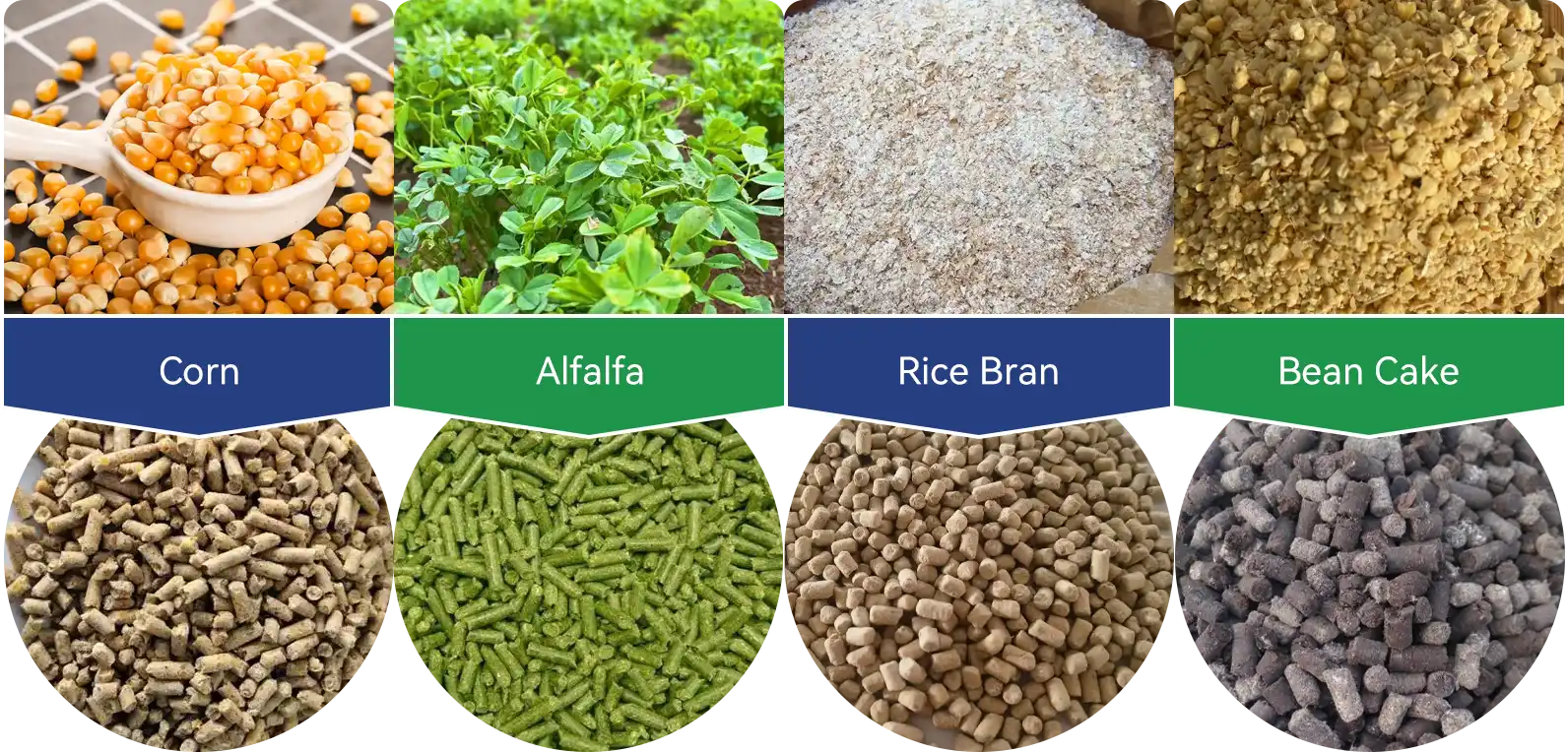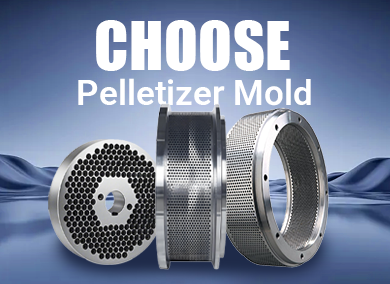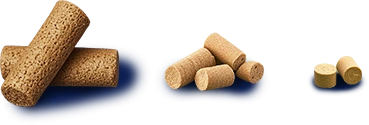Raising chickens is popular everywhere. To reduce production costs, consider making your own chicken feed. Making your own feed pellets helps cut costs and gives your chickens better nutrition.
We'll show you how to make homemade chicken feed pellets with a pellet machine. It covers four key areas: ingredients and formulas, the production process, important precautions, and the benefits of pellet feed.

Raw Materials and Formulas for Homemade Chicken Feed Pellets
Understanding the ingredients and feed formulas is the first and most crucial step in making chicken feed pellets. This knowledge makes the whole process much smoother.
Raw Materials for Homemade Chicken Feed Pellets
You can make chicken feed pellets using a wide range of ingredients. These include grains like oats and barley, protein sources such as peas and fishmeal, and extras like seaweed, flaxseed, and alfalfa. These ingredients are both affordable and easy to source.

Formulas for Homemade Chicken Feed
Below are some formulas suitable for different breeds of chickens.
Broiler Chick Starter Feed Formula:
| Ingredient | Formula 1 | Formula 2 | Formula 3 |
| Corn (%) | 55.3 | 54.2 | 55.2 |
| Soybean Meal (%) | 38 | 34 | 32 |
| Vegetable Meal (%) | - | 5 | - |
| Fish Meal (%) | - | - | 2 |
| Canola Meal (%) | - | - | 4 |
| Dicalcium Phosphate (%) | 1.4 | 1.5 | 1.5 |
| Limestone (%) | 1 | 1 | 1 |
| Salt (%) | 0.3 | 0.3 | 0.3 |
| Oil (%) | 3 | 3 | 3 |
| Additives (%) | 1 | 1 | 1 |
Broiler Grower Feed Formula:
| Ingredient | Formula 1 | Formula 2 | Formula 3 |
| Corn (%) | 58.2 | 57.2 | 57.7 |
| Soybean Meal (%) | 35 | 31.5 | 27 |
| Vegetable Powder (%) | - | 5 | 4 |
| Fish Meal (%) | - | - | 2 |
| Dicalcium Phosphate (%) | 1.4 | 1.3 | 1.3 |
| Limestone (%) | 1.1 | 1.2 | 1.2 |
| Salt (%) | 0.3 | 0.3 | 0.3 |
| Oil (%) | 3 | 2.5 | 2.5 |
| Additives (%) | 1 | 1 | 1 |
Broiler Finisher Feed Formula:
| Ingredient | Formula 1 | Formula 2 | Formula 3 |
| Corn (%) | 60.2 | 59.2 | 60.7 |
| Wheat Bran (%) | 3 | 2 | - |
| Soybean Meal (%) | 30 | 22.5 | 21 |
| Vegetable Meal (%) | - | 9.5 | 4.5 |
| Fish Meal (%) | - | - | 2 |
| Canola Meal (%) | - | - | 4.5 |
| Cottonseed Meal (%) | - | - | 5 |
| Dicalcium Phosphate (%) | 1.3 | 1.3 | 1.3 |
| Limestone (%) | 1.2 | 1.2 | 1.2 |
| Salt (%) | 0.3 | 0.3 | 0.3 |
| Oil (%) | 3 | 3 | 3 |
| Additives (%) | 1 | 1 | 1 |
(Adding 5-10% glucose or sucrose to the drinking water before feeding broiler chicks helps promote their recovery and growth.)
Layer Chick Starter Feed Formula:
| Ingredient | Formula 1 | Formula 2 |
| Corn (%) | 62 | 60 |
| Bran (%) | 10 | 10 |
| Soybean Meal (%) | 17 | 22 |
| Fish Meal (%) | 9 | 6 |
| Bone Meal (%) | 2 | 2 |
Layer Grower Feed Formula:
| Ingredient | Formula 1 | Formula 2 |
| Corn (%) | 55 | 66 |
| Bran (%) | 20 | - |
| Soybean Meal (%) | 7 | 18 |
| Cottonseed Cake (%) | 5 | - |
| Canola Cake (%) | 5 | - |
| Fish Meal (%) | 5 | 3 |
| Bone Meal (%) | 2 | 1.5 |
| Shell Powder (%) | 1 | - |
| Salt (%) | - | 0.5 |
Layer Laying Feed Formula:
| Ingredient | Formula 1 | Formula 2 |
| Corn (%) | 56 | 68 |
| Bran (%) | 6 | 6 |
| Soybean Meal (%) | 17 | 8 |
| Fish Meal (%) | 5 | 10 |
| Shell Powder (%) | 3 | 6 |
| Crushed Stone (%) | 3 | - |
| Mixed Grains (%) | 10 | - |
| Salt (%) | 0.4 | - |
| Methionine (%) | 0.1 | - |
Chickens have different nutritional needs at various stages of growth. Combining the right ingredients for each stage is key to healthy growth.
Production Process for Homemade Chicken Feed Pellets
When producing chicken feed pellets with a pellet mill, there are four essential steps to follow.
1. Selecting the Right Raw Materials
It is essential to choose ingredients that can provide comprehensive nutrition and add the right supplements. You need to carefully control the ratio of each ingredient, as it affects the shelf life of the pellets.
2. Crushing and Mixing the Raw Materials
The pellet machine first crushes large ingredients into smaller pieces, then mixes them based on the selected feed formula.
3. Pelletizing Process
The mixed ingredients are placed into the feed pellet machine, where they are pressed into pellets under pressure. Adding a bit of water makes it easier for the pellets to form during pressing.
| Pellets Diameter | Target Poultry |
| 2.5mm | Chicks (0-4 weeks) |
| 4mm | Growers (5-20 weeks) |
| 6mm | Layers/Broilers (>20 weeks) |
4. Cooling and Storing the Pellets
After pelletizing, let the pellets cool to room temperature to prevent mold or spoilage during storage. To store pellets long-term, keep them at a temperature no more than 5°C above room temperature. Make sure the moisture content stays between 12% and 13%.
.webp)
Tips for Making Chicken Feed Pellets
To raise healthier, stronger chickens, you'll need to consider a few key factors when formulating their feed.
Calculate Nutritional Needs Based on Actual Conditions
Different types of chickens have different nutritional needs at various stages of growth. When making chicken feed pellets, you should calculate nutritional needs based on specific conditions and select ingredients accordingly. This will help maximize the efficiency of the feed pellets.
Choose the Right Feed Additives
You can improve the nutritional value of the feed by adding supplements like vitamins, minerals, amino acids, and antioxidants. Choose the types and amounts based on your chickens' needs.
Maintain Formula Consistency
Layer chickens and chicks are particularly sensitive to changes in their diet. Therefore, it is best not to change the feed formula frequently. When changing formulas, give your chickens about a week to adjust to the new feed.

Advantages of Pellet Feed
Compared to traditional chicken feed, pellet feed offers four main advantages.
Easy to Store and Transport
Pelletized feed is compact and smooth-making it easier to store and transport than regular feed.
Increased Feed Utilization and Absorption
Chickens naturally prefer pecking at hard objects, so pellet feed encourages them to eat more efficiently. The feed utilization rate can reach up to 95%, effectively reducing waste. Furthermore, since pellets are hard, chickens spend more time pecking, which improves digestion.
More Balanced and Comprehensive Nutrition
Feed pellets give chickens what they need at each stage, with balanced and complete nutrition. This is something that cannot be achieved with other feeding methods.
Low Production Cost
The raw materials for chicken feed pellets are easy to find, and the process is simple enough for you to learn quickly. Modern pellet machines make the process more efficient and economical. The low cost of investment and high returns make it an ideal choice for poultry feed production.

Using a feed pellet machine to produce chicken feed pellets is practical and easy. These machines can also be used to create feed for other livestock, such as sheep, cattle, pigs, ducks, and geese. Pellet machines help you control nutrition and directly improve animal health. This makes feed production more profitable and sustainable.






